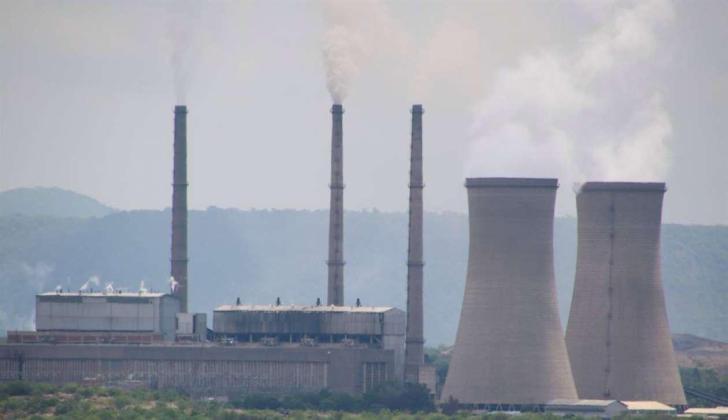News / National
Mnangagwa breaks ground for 720MW power plant in Hwange
02 Dec 2024 at 07:19hrs | Views

President Emmerson Mnangagwa today led the groundbreaking ceremony for a new 720MW thermal power plant in Hwange District, marking a major milestone for Matabeleland North Province and Zimbabwe's energy sector. The multi-million-dollar project, spearheaded by Titan Energy (Private) Limited in partnership with Zesa Holdings, underscores the government's commitment to accelerating economic growth in line with Vision 2030.
The project is set to address Zimbabwe's reduced power generation capacity, which has been strained by drought-affected hydroelectric production, particularly at Kariba Hydro-Power Station. Using waste coal from local mines, the plant will provide "captive energy" to meet the growing electricity demands of productive sectors while alleviating pressure on the national grid.
The first phase will deliver 160MW, with an additional 200MW solar plant planned for Phase 2. The power plant is expected to start feeding the grid by late 2025, ensuring continuous 24/7 base power for industrial and domestic users.
"This plant is very important as it will provide part of the base load. These captive plants also relieve pressure on Zesa, enabling it to supply other users more efficiently," said Dr. Gloria Magombo, Permanent Secretary in the Ministry of Energy and Power Development.
The Hwange power project is among the mega-deals facilitated by President Mnangagwa during the China-Africa Cooperation Summit in Beijing. It adds to a growing portfolio of high-value investments in Matabeleland North, a region rich in coal, mining, tourism, and agricultural resources.
The province has already benefited from significant projects under the Second Republic, including: The US$1.5 billion Hwange Thermal Power Station Units 7 and 8 expansion. The US$7.3 million SolGas Energy solar plant in Cross Mabale. Several coal mining ventures and power generation facilities.
Matabeleland North Provincial Affairs Minister Richard Moyo noted the project's economic ripple effects, with local businesses, traders, and accommodation providers experiencing increased activity due to the event.
Dr. Magombo highlighted the government's broader strategy to diversify Zimbabwe's energy mix by integrating renewable energy solutions alongside thermal projects. She revealed plans for 10 additional captive power plants slated for development next year, complementing the government's push for sustainable energy partnerships.
The initiative aligns with the National Development Strategy 1 (NDS1) and Vision 2030, which emphasize infrastructure development, resource utilization, and private-sector collaboration to spur economic growth.
Matabeleland North remains a focal point of the Second Republic's development agenda, with ongoing projects such as the Lake Gwayi-Shangani initiative, the Bubi-Lupane Irrigation Scheme, and the expansion of Victoria Falls International Airport.
In addition to energy projects, the government has prioritized investments in education and healthcare, including the establishment of Hwange Teachers' College, Binga Polytechnic, Lupane Provincial Hospital, and the Welshman Mabhena Government Complex.
The groundbreaking ceremony represents a historic moment for the region and the nation as Zimbabwe continues to attract investment in critical sectors. President Mnangagwa's leadership has paved the way for transformative projects that not only address current challenges but also position Zimbabwe as a competitive player in regional energy markets.
With the implementation of the 720MW power plant and other key developments, Matabeleland North is solidifying its status as a hub for energy innovation and economic growth.
The project is set to address Zimbabwe's reduced power generation capacity, which has been strained by drought-affected hydroelectric production, particularly at Kariba Hydro-Power Station. Using waste coal from local mines, the plant will provide "captive energy" to meet the growing electricity demands of productive sectors while alleviating pressure on the national grid.
The first phase will deliver 160MW, with an additional 200MW solar plant planned for Phase 2. The power plant is expected to start feeding the grid by late 2025, ensuring continuous 24/7 base power for industrial and domestic users.
"This plant is very important as it will provide part of the base load. These captive plants also relieve pressure on Zesa, enabling it to supply other users more efficiently," said Dr. Gloria Magombo, Permanent Secretary in the Ministry of Energy and Power Development.
The Hwange power project is among the mega-deals facilitated by President Mnangagwa during the China-Africa Cooperation Summit in Beijing. It adds to a growing portfolio of high-value investments in Matabeleland North, a region rich in coal, mining, tourism, and agricultural resources.
The province has already benefited from significant projects under the Second Republic, including: The US$1.5 billion Hwange Thermal Power Station Units 7 and 8 expansion. The US$7.3 million SolGas Energy solar plant in Cross Mabale. Several coal mining ventures and power generation facilities.
Matabeleland North Provincial Affairs Minister Richard Moyo noted the project's economic ripple effects, with local businesses, traders, and accommodation providers experiencing increased activity due to the event.
Dr. Magombo highlighted the government's broader strategy to diversify Zimbabwe's energy mix by integrating renewable energy solutions alongside thermal projects. She revealed plans for 10 additional captive power plants slated for development next year, complementing the government's push for sustainable energy partnerships.
The initiative aligns with the National Development Strategy 1 (NDS1) and Vision 2030, which emphasize infrastructure development, resource utilization, and private-sector collaboration to spur economic growth.
Matabeleland North remains a focal point of the Second Republic's development agenda, with ongoing projects such as the Lake Gwayi-Shangani initiative, the Bubi-Lupane Irrigation Scheme, and the expansion of Victoria Falls International Airport.
In addition to energy projects, the government has prioritized investments in education and healthcare, including the establishment of Hwange Teachers' College, Binga Polytechnic, Lupane Provincial Hospital, and the Welshman Mabhena Government Complex.
The groundbreaking ceremony represents a historic moment for the region and the nation as Zimbabwe continues to attract investment in critical sectors. President Mnangagwa's leadership has paved the way for transformative projects that not only address current challenges but also position Zimbabwe as a competitive player in regional energy markets.
With the implementation of the 720MW power plant and other key developments, Matabeleland North is solidifying its status as a hub for energy innovation and economic growth.
Source - The Herald



























